Abstract
Wingless/Wnt signalling directs cell-fate choices during embryonic development1,2. Inappropriate reactivation of the pathway causes cancer3,4,5. In Drosophila, signal transduction from Wingless stabilizes cytosolic Armadillo1, which then forms a bipartite transcription factor with the HMG-box protein Drosophila Tcf (dTcf) and activates expression of Wingless-responsive genes6,7,8. Here we report that in the absence of Armadillo, dTcf acts as a transcriptional repressor of Wingless-responsive genes, and we show that Groucho acts as a corepressor in this process. Reduction of dTcf activity partially suppresses wingless and armadillo mutant phenotypes, leading to derepression of Wingless-responsive genes. Furthermore, overexpression of wild-type dTcf enhances the phenotype of a weak wingless allele. Finally, mutations in the Drosophila groucho gene also suppress wingless and armadillo mutant phenotypes as Groucho physically interacts with dTcf and is required for its full repressor activity.
This is a preview of subscription content, access via your institution
Access options
Subscribe to this journal
Receive 51 print issues and online access
$199.00 per year
only $3.90 per issue
Buy this article
- Purchase on Springer Link
- Instant access to full article PDF
Prices may be subject to local taxes which are calculated during checkout




Similar content being viewed by others
References
Cadigan, K. M. & Nusse, R. Wnt signaling: a common theme in animal development. Genes Dev. 11, 3286–3305 (1997).
Bejsovec, A. & Peifer, M. The wingless/Wnt-1 signaling pathway — new insights into the cellular mechanisms of signal transduction. Adv. Dev. Biochem. 4, 1–45 (1996).
Rubinfeld, B. et al . Stabilization of β-catenin by genetic defects in melanoma cell lines. Science 275, 1790–1792 (1997).
Morin, P. J. et al . Activation of β-catenin-Tcf signalling in colon cancer by mutations in β-catenin or APC. Science 275, 1787–1790 (1997).
Korinek, V. et al . Constitutive transcriptional activation by a β-catenin-Tcf complex in APC(−/−) colon carcinoma. Science 275, 1784–1787 (1997).
Brunner, E., Peter, O., Schweizer, L. & Basler, K. pangolin encodes a Lef-1 homolog that acts downstream of Armadillo to transduce the Wingless signal. Nature 385, 829–833 (1997).
Riese, J. et al . LEF-1, a nuclear factor coordinating signalling inputs from wingless and decapentaplegic. Cell 88, 777–787 (1997).
van de Wetering, M. et al . Armadillo co-activates transcription driven by the product of the Drosophila segment polarity gene dTCF. Cell 88, 789–799 (1997).
Brannon, M., Gomperts, M., Sumoy, L., Moon, R. T. & Kimelman, D. A. β-catenin/XTcf-3 complex binds to the siamois promoter to regulate dorsal axis specification in Xenopus. Genes Dev. 11, 2359–2370 (1997).
DiNardo, S., Kuner, J. M., Theis, J. & O'Farrell, P. H. Development of the embryonic pattern in D. melanogaster as revealed by the accumulation of the nuclear engrailed protein. Cell 43, 59–69 (1985).
DiNardo, S., Sher, E., Heemskerk-Jongens, J., Kassis, J. A. & O'Farrell, P. Two-tiered regulation of spatially patterned engrailed gene expression during Drosophila embryogenesis. Nature 322, 604–609 (1988).
Martinez Arias, A., Baker, N. & Ingham, P. Role of the segment polarity genes in the definition and maintenance of cell states in the Drosophila embryo. Development 103, 157–170 (1988).
Bejsovec, A. & Martinez-Arias, A. Roles of wingless in patterning the larval epidermis of Drosophila. Development 113, 471–485 (1991).
Heemskerk, J., DiNardo, S., Kostriken, R. & O'Farrell, P. H. Multiple modes of engrailed regulation in the progression towards cell fate determination. Nature 352, 404–410 (1991).
Peifer, M. & Wieschaus, E. The segment polarity gene armadillo encodes a functionally modular protein that is the Drosophila homolog of human plakoglobin. Cell 63, 1167–1178 (1990).
Von Ohlen, T., Lessing, D., Nusse, R. & Hooper, J. E. Hedgehog signaling regulates transcription through cubitus interruptus, a sequence-specific DNA binding protein. Proc. Natl Acad. Sci. USA 94, 2404–2409 (1997).
Hepker, J., Wang, Q. T., Motzny, C. K., Holmgren, R. & Orenic, T. V. Drosophila cubitus interruptus forms a negative feedback loop with patched and regulates expression of Hedgehog target genes. Development 124, 549–558 (1997).
Tiong, S. Y. K. & Nash, D. Genetic analysis of the adenosine3 (Gart) region of the second chromosome in Drosophila melanogaster. Genetics 124, 889–897 (1990).
Roose, J. et al . The Xenopus Wnt effector XTcf-3 interacts with Groucho-related transcriptional repressors. Nature 395, 608–612 (1998).
Behrens, J. et al . Functional interaction of β-catenin with the transcription factor LEF-1. Nature 382, 638–642 (1996).
Paroush, Z. et al . groucho is required for Drosophila neurogenesis, segmentation, and sex determination and interacts directly with Hairy-related bHLH proteins. Cell 79, 805–815 (1994).
de Celis, J. F. & Ruiz-Gomez, M. groucho and hedgehog regulate engrailed expression in the anterior compartment of the Drosophila wing. Development 121, 3467–3476 (1995).
Noordermeer, J., Johnston, P., Rijsewijk, F., Nusse, R. & Lawrence, P. A. The consequences of ubiquitous expression of the wingless gene in the Drosophila embryo. Development 116, 711–719 (1992).
Bejsovec, A. & Wieschaus, E. Signaling activities of the Drosophila wingless gene are separately mutable and appear to be transduced at the cell surface. Genetics 139, 309–320 (1995).
Baker, N. E. Molecular cloning of sequences from wingless, a segment polarity gene in Drosophila: the spatial distribution of a transcript in embryos. EMBO J. 6, 1765–1773 (1987).
Schrons, H., Knust, E. & Campos-Ortega, J. A. The Enhancer of split complex and adjacent genes in the 96F region of Drosophila melanogaster are required for segregation of neural and epidermal progenitor cells. Genetics 132, 481–503 (1992).
Acknowledgements
This work was supported by grants from the NIH and the U.S. Army Breast Cancer Research Program (to M.P.), the NSF and the March of Dimes Birth Defects Foundation (to A.B.) and the NWO-GMW (to H.C.).
Author information
Authors and Affiliations
Corresponding author
Rights and permissions
About this article
Cite this article
Cavallo, R., Cox, R., Moline, M. et al. Drosophila Tcf and Groucho interact to repress Wingless signalling activity. Nature 395, 604–608 (1998). https://doi.org/10.1038/26982
Received:
Accepted:
Issue Date:
DOI: https://doi.org/10.1038/26982
This article is cited by
-
New insights in ubiquitin-dependent Wnt receptor regulation in tumorigenesis
In Vitro Cellular & Developmental Biology - Animal (2024)
-
Wnt signaling is boosted during intestinal regeneration by a CD44-positive feedback loop
Cell Death & Disease (2022)
-
Molecular pathogenesis of desmoid tumor and the role of γ-secretase inhibition
npj Precision Oncology (2022)
-
Wnt Signaling Pathways: A Role in Pain Processing
NeuroMolecular Medicine (2022)
-
CREPT serves as a biomarker of poor survival in pancreatic ductal adenocarcinoma
Cellular Oncology (2021)
Comments
By submitting a comment you agree to abide by our Terms and Community Guidelines. If you find something abusive or that does not comply with our terms or guidelines please flag it as inappropriate.



